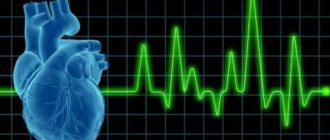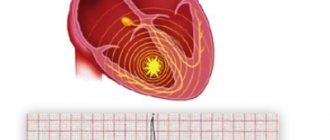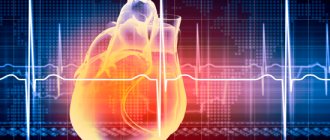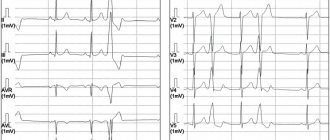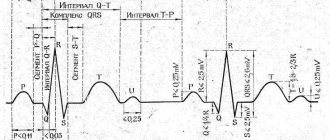Heart arythmy
- Symptoms of cardiac arrhythmia
- Why is cardiac arrhythmia dangerous?
- Which doctor will help with arrhythmia?
- Types of arrhythmia
- Causes of the disease
Arrhythmia refers to any disturbance in the heart rate. According to statistics, more than 15 percent of people who suffer from heart problems die from this disease. There are many reasons for the appearance of arrhythmia. The disorder may be associated with the course of various diseases, sometimes not related to the cardiovascular system. Cardiac arrhythmia also occurs in completely healthy people. It can be both a sign and a cause of the development of serious diseases.
1. Heart rhythm disturbances
Normal heart function is, as a rule, subjectively imperceptible. Only when you are scared, rise sharply or jog do you feel a palpitation. If there are objective reasons for changes in heart rate, then this is a harmless and transient physiological reaction to internal and external changes. Unfortunately, interruptions in heart rhythm
can occur for no apparent reason, and the average age of onset of cardiac dysfunction is steadily decreasing.
Evolutionarily, it so happened that the work of the heart becomes noticeable to the person himself only when cardiac arrhythmias occur. Even a single freezing of the heart or its too strong contraction is felt as an interruption or a jolt. Arrhythmia
It can be an independent cardiac disease (congenital or acquired), accompany other diseases, or represent a reaction to external factors or internal conditions.
A must read! Help with treatment and hospitalization!
2.Types of arrhythmias
Heart disorders are divided into three types:
Tachycardia.
Cardiopalmus. Pulse from 90 beats per minute. Tachycardia that occurs for natural reasons should quickly subside as motor activity decreases or soon after the causes of the fright are eliminated. If tachycardia is permanent, it is necessary to contact a cardiologist, since increased heartbeat leads to exhaustion of the heart and may indicate serious illness.
Bradycardia.
Pulse less than 60 beats per minute. Heart rate can be reduced in athletes, since the developed heart muscle outside of training is able to perform its functions with normative efficiency with less frequent contractions. However, if a decrease in heart activity is not associated with an increase in its internal volume, then bradycardia is dangerous due to fainting, deterioration of blood supply to the brain and other organs, oxygen starvation, and carries the risk of complete cardiac arrest.
Extrasystole.
Random disturbances in the functioning of the heart: fading, strong tremors, alternation of a rapid or slow rhythm with a normal one. If the cause of such interruptions is not stress, serious physical activity or the use of energy drinks or alcohol, then this phenomenon may signal serious myocardial damage, endocrine or vegetative-vascular diseases.
Visit our Cardiology page
Why is cardiac arrhythmia dangerous?
Rhythm disturbances can occur for various reasons. In most cases, arrhythmia is not associated with serious illness. However, if a person experiences regular changes in their pulse, then you should not postpone visiting a doctor. Many people are interested in the dangers of cardiac arrhythmia. Rhythm disturbances can lead to:
- severe drop in blood pressure;
- circulatory disorders;
- the occurrence of blood clots;
- oxygen deficiency in internal organs;
- myocardial infarction;
- pulmonary edema;
- angina pectoris;
- cardiovascular failure.
You can find out what else is dangerous about this disease and what complications it can cause after visiting a doctor.
Preventive measures will help prevent the development of the disease. This should be taken especially seriously by those who are at risk:
- those suffering from excess weight;
- people over 60 years of age;
- persons with high blood pressure;
- patients with diabetes mellitus.
3. Causes of heart rhythm disturbances
The following factors can cause interruptions in heart rhythm:
- long stay in a stuffy, hot room;
- running, fast descent or ascent;
- long-term stress or deep one-time psychological trauma;
- prolonged stress, lack of sleep, high degree of responsibility;
- excessive physical activity without gradually increasing it;
- hypothermia;
- alcohol or drug intoxication.
These factors are subject to correction, and their elimination normalizes heart function. However, it has been observed that exposure to similar conditions and situations causes an arrhythmia identical to the one that arose in the first episode.
More serious and sometimes irreversible conditions characterized by arrhythmia can be caused by the following factors:
- endocrine disorders;
- anemia;
- vascular diseases;
- malignant tumors;
- myocardial infarction;
- pericarditis;
- congenital and acquired heart defects;
- lung diseases,
- chronic alcoholism, drug addiction and substance abuse;
- viral diseases;
- rheumatoid changes in the heart;
- obesity.
There are some conditions under which a person is at risk for developing arrhythmia:
- congenital heart pathologies;
- age over 45 years;
- excess weight, especially if fat deposits are localized in the abdomen and chest;
- high cholesterol, vascular and thyroid diseases.
About our clinic Chistye Prudy metro station Medintercom page!
4. The danger of arrhythmia and measures in case of interruptions in heart rhythm
An abnormal heart rhythm may not be accompanied by pain or other unpleasant sensations other than “fluttering in the chest” or the feeling of your own uneven heartbeats. However, it is extremely dangerous to treat sudden changes in heart rate as a normal ailment that will “go away on its own.” The insidiousness of cardiac disorders is that the gradual wear and tear of the heart can at some point lead to a sudden life-threatening condition requiring emergency medical attention. It could be:
- ischemic stroke;
- acute heart failure;
- heart block (complete stop of heart contractions);
- myocardial infarction.
Any systematic or persistent heart rhythm disturbances should be a reason to contact a cardiologist and conduct a thorough diagnosis. This is necessary to identify the causes of arrhythmia and take measures to eliminate factors affecting heart rhythm.
Diagnostics may include:
- echocardiography;
- ECG;
- daily monitoring;
- MRI, including duplex scanning;
- functional diagnostics with load.
Further treatment
depends on the diagnosis and the factors that led to interruptions in heart rhythm. Sometimes it is enough to give up bad habits, move more, spend time in the fresh air, optimize your work and rest schedule, lose excess weight, and reduce the fat content in your diet.
If the cause of arrhythmia is heart disease or diseases of other organs and systems, then appropriate therapy is prescribed. Surgical, sanatorium-resort and inpatient treatment can also be used. Sometimes it is necessary to strictly follow a number of rules and restrictions throughout your life to maintain proper heart function and reduce the risk of developing more severe conditions.
Arrhythmia can occur unnoticed, but at the same time lead to serious consequences
Do you often listen to your fiery engine beat?
In fact, if everything is in order, you practically do not pay attention to its work. It knocks and knocks... But there are states when it suddenly begins to throw somersaults, losing its usual rhythm: it treacherously freezes or, on the contrary, pounding furiously. There can be many reasons for disruption of the usual heart “melody”. Sometimes one of them is arrhythmia. What to do if your heart loses its rhythm? On the one hand, cardiologists urge not to panic. On the other hand, be more attentive to your health, learn to listen to your body. Leading researcher at the laboratory of cardiac disorders, Alexander CHASNOYT, confirms that “finding” the symptoms of an insidious disease is not so easy. — Alexander Robertovich, what diseases can cause the development of arrhythmia?
— First of all, arterial hypertension. It’s not for nothing that they say that hypertension is a silent epidemic that is actually raging in the world. More and more people are becoming ill with it under conditions of increased stress and psycho-emotional tension. And also coronary heart disease, heart failure.
Arrhythmias are divided into two large groups: tachyarrhythmia and bradyarrhythmia. The first is due to the fact that the heart beats frequently, and extraordinary excessive contractions occur - those that should not normally exist. The most common in the world today is ciliated. In the European population, it is diagnosed in 2-3 percent of the population. In Belarus the figure is approximately the same. The second large group is bradyarrhythmia, when the pulse beats rarely. Associated with insufficient heart rate.
The insidiousness of the disease is that it can proceed without expressing itself in any way. But in both cases, our heart has a hard time, its activity is disrupted, and this can cause complications.
- But is it possible to determine by any change in well-being, for example, by pulse, that the rhythm is starting to go crazy? What are the first signs?
- The pulse rate will reflect pronounced rhythm disturbances - blockade or tachycardia. But between them, for example, extrasystole is masked. It is impossible to determine it by the beating of the pulse. The fact is that extrasystoles are single extraordinary contractions. And that’s why you simply won’t “hear” them when you feel those very normal 80 beats per minute for a healthy person. But it will tell you that there is a rhythm disturbance, not in their number, but in their unevenness.
- Will a person somehow feel it?
— There are people who do not feel any disturbance in their heart rhythm at all. That is, they experience them, and they are quite severe, even tachycardia, atrial fibrillation with a high pulse rate, but they do not feel it. Such violations can be detected completely by accident, for example, during a routine medical examination or medical examination.
Arrhythmia - from the ancient Greek word “inconsistency, awkwardness.” A pathological condition leading to a violation of the frequency, rhythm and sequence of heart contraction. Essentially, it is any heart rhythm that deviates from the normal sinus rhythm, which can lead to serious health complications.
— They say that modern blood pressure monitors indicate a problem...
— Those equipped with an arrhythmia indicator function. Today, many manufacturers have such technologies. They evaluate how rhythmic or arrhythmic the pulse is, and if certain heartbeat irregularities occur, they will let you know with an icon or signal. There are also devices that can detect atrial fibrillation. This, by the way, is one of those arrhythmias that, along with atrial flutter, has an unfavorable long-term prognosis. It is associated not only with pathology of the heart, but also of the brain, in the form of complications such as stroke. Therefore, certain efforts of world science are aimed at early diagnosis of the so-called hidden, “silent” atrial fibrillation in order to prevent adverse consequences in time. On a regular short ECG, especially if a person rarely visits a doctor, it is also difficult to register. Therefore, today they are trying to detect it by introducing a special algorithm in a tonometer. First of all, this applies to patients aged 60 years and older (at this age the likelihood of atrial fibrillation significantly increases).
By the way, today there are already devices that, if connected to a smartphone, allow you to register an ECG. Just touch it with your fingers, and the phone will record your cardiogram. This helps to explore the rhythm and pulse.
— While a person feels healthy, he, you see, doesn’t particularly want to contact doctors or go to the clinic.
- Alas. But this would help in the early detection of any diseases. We are now trying to identify patients who have an increased risk of sudden death from heart failure. For such people, we have developed special diagnostic and treatment methods, including the implantation of radioverter-defibrillators - devices that are implanted under the skin and can restore the rhythm, saving lives. They monitor the work of the heart around the clock, detect a failure, and automatically carry out therapy. Republican Scientific and Practical Center "Cardiology" is the leader in the number of patients treated with rhythm disturbances of a vital organ. Every year we perform about a thousand such interventions.
Thus, today in every region we routinely implant pacemakers and other devices. Last year, more than 3,300 of them were implanted across the republic. About 1,200 radiofrequency ablations of tachyarrhythmias were performed - procedures in which a problem area is “cauterized” in the heart, which allows one to alleviate or get rid of the symptoms of arrhythmia. Regarding the work of our Heart Rhythm Laboratory, its staff has extensive scientific experience. We pay considerable attention to atrial fibrillation and flutter. We have developed several algorithms for diagnostic approaches, complex and hybrid methods for the treatment of atrial fibrillation. Development is currently underway to help and prevent the risk of sudden cardiac death.
Among the reasons
heart rhythm disturbances are called coronary heart disease, myocardial infarction, heart failure, acquired defects, myocarditis, mitral valve prolapse.
Congenital diseases and hormonal imbalances can affect the development of arrhythmia. In addition, taking certain medications - cardiac glycosides, diuretics, antiarrhythmics, concomitant and chronic diseases, and, of course, the well-known bad habits - smoking and alcohol. With arrhythmia, a person may complain
of weakness, lack of air, dizziness, and darkening of the eyes. This happens because the heart does not supply as much oxygen to the body as required.If the rhythm is rare, even loss of consciousness is possible.
— But are surgical methods a last resort when conservative methods are no longer effective?
- Exactly. That is why prevention, a healthy lifestyle, and the correction of concomitant, chronic diseases are so important. Practice shows that those diagnosed with arterial hypertension do not always adhere to treatment and do not properly control their blood pressure. And this is all the key to the formation of pathology of the cardiovascular system for the future, including the development of heart rhythm disturbances.
— Can arrhythmia manifest itself during stress, climbing stairs, or light jogging?
